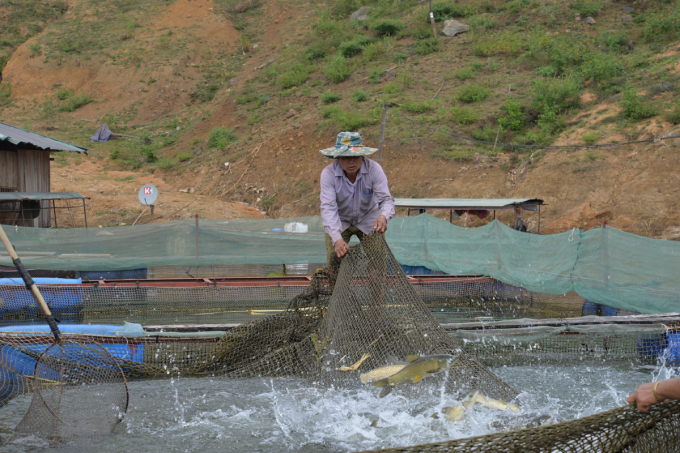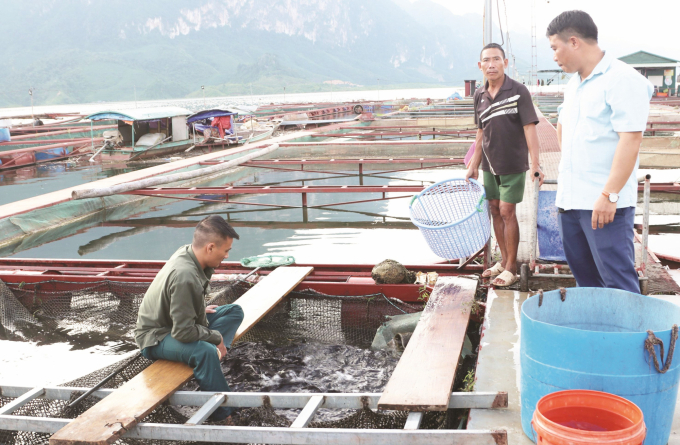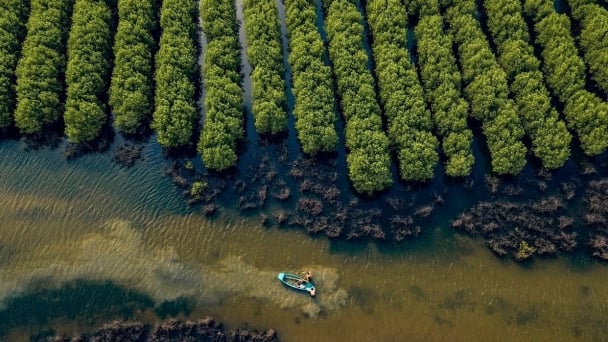June 14, 2025 | 03:03 GMT +7
June 14, 2025 | 03:03 GMT +7
Hotline: 0913.378.918
June 14, 2025 | 03:03 GMT +7
Hotline: 0913.378.918
On the day Son La Hydropower blocked the flow to raise the water level, many locals by the reservoir bed were confused since they lost lots of maize and cassava crops. However, today, the water surface of the Son La Hydropower Reservoir is becoming a potential source for them to enrich their living thanks to aquaculture.
Especially in recent years, reservoir-bed aquaculture households have joined together and established many cooperatives in the production and consumption of their products. Thanks to that, farmers have overcome difficulties including market incidents due to the Covid-19 pandemic in 2021.

Cooperation in reservoir-bed fish raising has opened up a direction for sustainable enrichment for people in the Son La Hydropower area. Photo: Nguyen Thieu.
Chieng On Commune has many advantages for development of cage fish farming on the bed of Son La Hydropower reservoir. Up to now, the whole commune has 10 fisheries cooperatives with over 1,300 fish cages and 100 members. For many years, the local authorities and people have taken advantage of the reservoir’s water surface as a "lever" for socio-economic development, and to build a new rural area.
In the past, life of households in Chieng On was very difficult as they mainly relied on cultivation. However, in recent years, realizing that the hydropower reservoir is large in with good water environment, people have turned to aquaculture and fishing there.
Mr. Lam Duc Do, Director of Ho Quynh Cooperative, Chieng On Commune, said due to the effective cage-fish farming, in recent years, the cooperative has boosted investment in the cage system. Up to now, after 9 years, the cooperative has had 8 members who are owning 160 cages able for raising all kinds of fish such as carp, catfish, lentils, and black lentils...
To promote and introduce Da River fish to markets, the cooperative has actively connected with traders, restaurants, and hotels to find stable output for their products. On average, after each crop of 18 months, they can harvest about 3 to 4 tons of fish from a cage. With 160 cages, each crop can help the cooperative earn about VND4 billion.

Quynh Nhai District, Son La Province regularly holds conferences on sustainable fish farming models for people to learn and replicate. Photo: Nguyen Thieu.
Quynh Nhai has a lakebed area of more than 10,500 ha with 72 km long, spreading through 9 communes around the Son La Hydropower Plant. The communes include Chieng Khoang, Nam Et, Muong Sai, Muong Giang, Chieng On, Pa Ma Pha Khinh, Muong Chien and Ca Nang. This is a favorable condition for people to develop cage fish farming and aquaculture.
Up to now, it has 47 fisheries cooperatives and a union of fisheries cooperatives. The whole district has more than 6,000 fish cages. Since the beginning of 2021, the total aquaculture production in the area is estimated at over 1,200 tons, of which output from cage fish raising has reached 761 tons and those from river shrimp and the fish catch is about 500 tons.
Cage fish farming on Son La Hydropower Reservoir is an effective economic development direction of many localities in the district. Currently, on average, each fish cage can give a profit of VND10 to 15 million/crop. Cooperatives and households applying farming techniques can even earn tens of millions of dong.
According to Quynh Nhai People's Committee, the district currently has 578 organizations and households engaging in fishery activities. Along with a focus on guiding cooperatives and households to maintain and develop aquaculture, in 2021, the Committee guided them to release more than 9,600 fish breeds to regenerate aquatic resources in the reservoir bed and promoted more supports for them in consuming more than 36 tons of black lentils…
To prepare for consuming agricultural products, especially cage fishery products at the end of 2021 and for Lunar New Year 2022, Quynh Nhai has also set up consuming plans in the situation of the Covid-19 pandemic.

Reservoir fish farming has helped change the life of many localities in Son La. Photo: Thieu Nguyen.
Ms. Bac Thi Mai, a member of Son Mai Fisheries Cooperative (Chieng On Commune) said this year, the cooperative faced many difficulties due to the Covid-19 pandemic. However, it has tried to maintain raising many species of fish in cages on the reservoir bed, The cooperative has also promoted marketing its fish products to traders in Hanoi every month and has received good feedback for the quality.
To create favorable conditions for consumption of agricultural and aquatic products during the Covid-19 outbreaks, the Chieng On People's Committee is actively promoting growers to maintain and take care of their fish cages so that to promptly supply adequate fish for consumption at the end of the year and for the Lunar New Year 2022.

Along with the potential of the water surface, Son La is directing people to sustainable farming, along with protecting the ecological environment and regenerating aquatic resources. Photo: BDT.
The district has also been actively developing a scenario for the seafood consumption market in the last months of the year and the Lunar New Year of the Tiger in 2022.
According to Mr. Cam Van Huy, Vice Chairman of Quynh Nhai People's Committee, in 2021, the district has removed obstacles, restored production, circulation, consumption and export of agricultural products, especially at the end of 2021 and the Lunar New Year.
At the same time, it has strengthened support for cooperatives and business households to apply safe production processes following the VietGAP standards, ensure food hygiene and safety, increase competitiveness, and create favorable conditions for goods on sales in supermarkets, commercial centers and chain stores...
In the coming time, Quynh Nhai will strengthen technical training for farmers in fish farming in ponds and reservoir cages to help them switch to highly intensive aquaculture.

In the coming time, Son La Province and its districts will focus on infrastructure investment in reservoir-bed aquaculture areas. Photo: Thieu Nguyen.
Besides, working groups will be set up throughout from districts to communes to boost the management, exploitation, and protection of aquatic resources in the Son La Hydropower Reservoir area.
Farming of some species with high economic value will be expanded focusing on areas in communes of Chieng On, Chieng Bang, Nam Et, and Muong Giang.
Quynh Nhai District is paying special attention to setting up a plan on upgrading and effectively exploiting infrastructure such as those in fishing wharves of Muong Giang, Pa Ma Pha Khinh, Chieng On, and Chieng Bang communes to boost market consumption.
Moreover, the district will also create favorable conditions to support cooperatives in processing from their farmed fish; focus on managing and developing the brand name "Da Son La River Fish"; continue to evaluate caged fish farming according to VietGAP and GlobalGAP standards, aiming to improve the quality of farmed fish to meet market demands as well as ensure sustainable development with stable incomes for locals.
Translated by Linh Nguyen

(VAN) In Tien Giang, a high-tech shrimp farm has developed a distinctive energy-saving farming model that has yielded promising results.
![Turning wind and rain into action: [3] 300.000 farmers benefit from agro-climatic bulletins](https://t.ex-cdn.com/nongnghiepmoitruong.vn/608w/files/news/2025/06/12/e5a48259d6a262fc3bb3-nongnghiep-125122.jpg)
(VAN) The agro-climatic bulletin has become a valuable tool for farmers in the Mekong Delta. After more than five years of implementation, the initiative is gradually being expanded nationwide.
![Turning wind and rain into action: [2] Providing forecasts to the people](https://t.ex-cdn.com/nongnghiepmoitruong.vn/608w/files/news/2025/06/12/e5a48259d6a262fc3bb3-nongnghiep-103927.jpg)
(VAN) In addition to improving the quality of hydrometeorological forecasts, putting forecast bulletins into practical use is crucial for production and disaster prevention.

(VAN) Blue carbon is receiving attention for its rapid absorption capacity and vast potential. It represents a promising nature-based solution to respond to climate change.
/2025/06/11/3507-1-161904_583.jpg)
(VAN) Seagrass beds and coral reefs serve as 'cradles' that nurture life in the ocean depths, creating rich aquatic resources in Vietnamese waters.
![Turning wind and rain into action: [1] Forecasting for farmers](https://t.ex-cdn.com/nongnghiepmoitruong.vn/608w/files/news/2025/06/11/e5a48259d6a262fc3bb3-nongnghiep-111919.jpg)
(VAN) Weather is no longer just a matter of fate. Forecasts have now become an essential companion for farmers in every crop season.
/2025/06/10/2501-3-082025_983.jpg)
(VAN) Mr. Le Hoang Minh, Head of Vinamilk's Net Zero project, recently shared insights on the integration of production, energy, and technology in Vinamilk’s green transition journey.